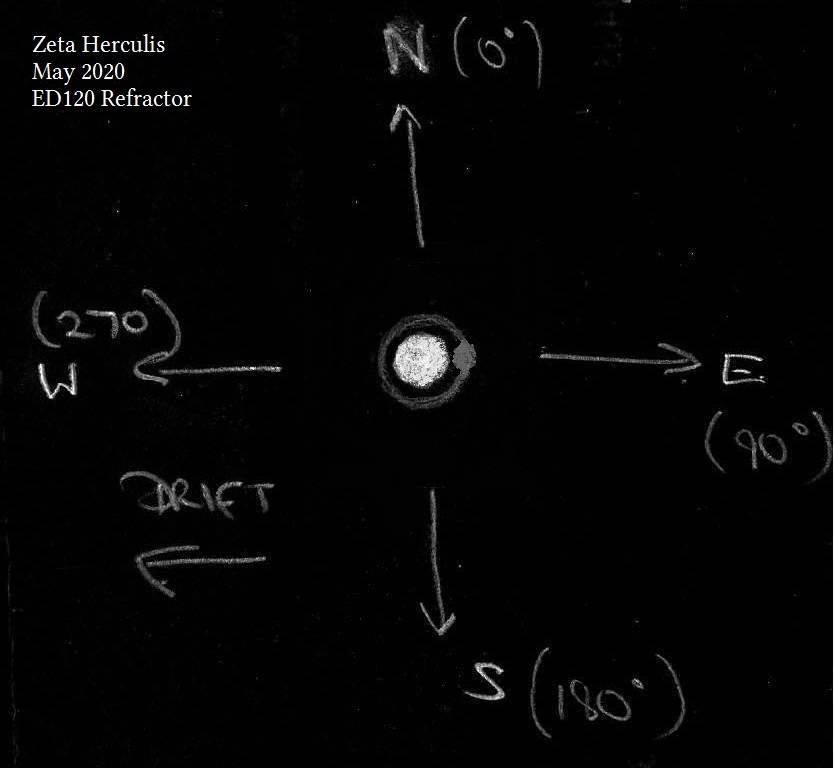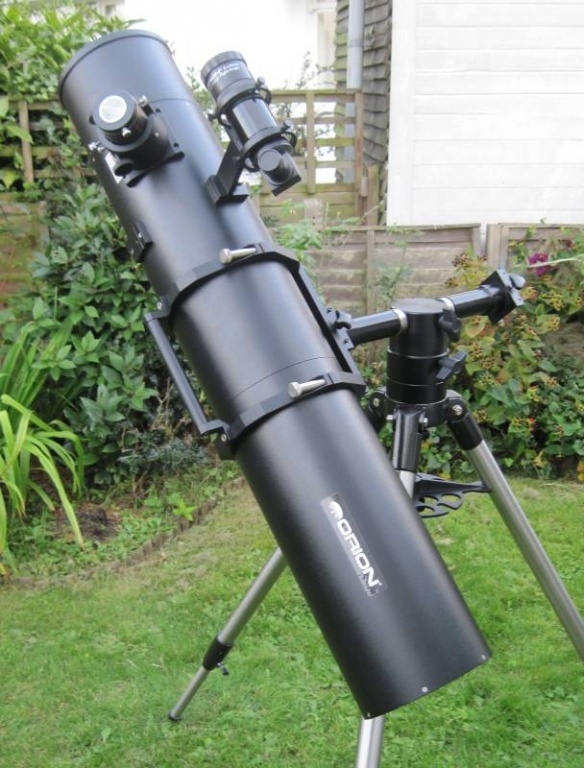-
Posts
53,760 -
Joined
-
Last visited
-
Days Won
455
Content Type
Profiles
Forums
Gallery
Events
Blogs
Posts posted by John
-
-
Pretty good summary of the options there from Louis

A 35mm would give you a 3 degree true field compared to the 2 degrees that the 25mm X-Cel LX delivers. Quite a gain.
-
 1
1
-
-
If both component stars were the same brightness, Zeta Herc would be a relatively easy split but with the primary at mag 2.95 and the secondary at mag 5.4 it becomes a much tougher challenge.
Similarly with Sirius - the separation there is a pretty straightforward 10 arc seconds but the brightness difference between Sirius and "The Pup" is massive, the latter being 10,000 times dimmer than the primary.
-
 1
1
-
-
I had a DGM NBP filter for quite a while. It was very effective as I recall. I just found that I was using an O-III much more often so I let the NBP go.
Then I missed having a UHC of course

So I got a couple of lower cost ones (ES UHC and Meade 4000 Narrowband) which are not bad but don't have quite the impact that the NBP had. If I find myself reaching for UHC more often I'll have to get another NBP.
-
4 minutes ago, Mark at Beaufort said:
John now that the secondary is at 90 degrees due East the view in A Newtonian will be the same - although South will be at the top. I think I am correct?
Yes, I think that is correct Mark.
-
They look very good Stu

-
I didn't know about this phenomenon which is unique to Mercury, until this link was posted on my society forum by Nigel Wakefield. I found it very interesting so I thought I would share it here - hope that is OK Nigel ?

https://spaceweathergallery.com/indiv_upload.php?upload_id=163365
Andrea Alessandrini has done really well to capture this.
Looking further into this I came across this NASA web page on it:
https://www.nasa.gov/image-feature/mercurys-sodium-tail
I'm sure there is plenty more out there on this.
It's good to learn new stuff - thanks Nigel

-
 4
4
-
 4
4
-
-
Does averted vision bring rods or cones into play ?
It certainly works !
-
 1
1
-
-
Meade did two versions of their AR5 - one with collimation facilities on the objective cell and one without. The Bresser 127L has the latter and is a clone of the Meade AR5 LXD75 tubes. I've actually owned both the Meade and the Bresser versions.
If you want a "big" refractor experience I agree that these 127mm F/9ish achromats deliver that. Strangely, in a way that a 120mm doesn't quite manage ?
The earlier 127's could do with longer dew shields though which it looks as if Bresser have sorted now.
150mm F/8 - 127mm F/9.3 - 102mm F/6.5


-
 2
2
-
-
PS: you don't really get a "snowman" or "peanut" effect with this one. The secondary star looks rather like a tiny blob of dirty blu-tak stuck onto the diffraction ring !
-
 1
1
-
-
I first managed Zeta Herc back in 2013 with my ED120. Kerry has kindly posted the 2016 version above and below is a re-vamp from May this year. As you can see the position angle has changed a bit. I think the gap is a touch wider now as well but it is still a challenging split:

-
 3
3
-
 1
1
-
-
Orion (USA) is a re-brander. Today a lot (but not all) of their stuff is made by Synta who also own the Skywatcher brand and Celestron now as well. Orion branded stuff tends to be on the expensive side in the UK compared to the same product under Skywatcher or Celestron branding. In the past Orion have carried products made by Vixen in Japan and Intes in Russia. Below is a maksutov-newtonian that I used to own. It was made by Intes in Russia, their name for it is the MN61 but my example was re-branded a black livery by Orion and called "The Argonaut". I've owned a couple of their filters, the Skyglow broadband which I found did not make much difference and the Ultrablock UHC type which I found quite effective. I understand that the Ultrablocks can be very variable in their transmission ranging from the pretty good to the rather mediocre.
Who would have thought that the subject of deep sky filters was as complicated ?

-
 1
1
-
-
53 minutes ago, markse68 said:
Btw, anyone any idea how much a 2x Barlow shifts the focal point or is that a complex thing to determine?
Depends on the focal length of the barlow I think. Not a spec that is regularly published

-
-
"little set up"

-
1 hour ago, Cyril said:
Seems Musk is trying to 'own' near earth with his latest, today's, launch of another 54 satellites, who actually gave him permission?
The Federal Communications Commission (FCC):
-
 1
1
-
-
Congratulations Paul - super looking setup !
These Vixen mounts are really nicely made

-
 1
1
-
-
Lots of clouds here so not observing.
Hope somebody gets some sort of view with their dob somewhere

-
 1
1
-
-
8 hours ago, FMA said:
I was checking flo web and for my skywatcher h5 only comes in 5 kg. I need something Lighter!
You can get 3.4kg and 1.8kg that will fit your mount I think. Just need to check the diameter of the shaft. If it is 20mm than that is the same as the EQ5 / HEQ5 / Skytee II etc.
-
Still pushing the £1K EP's ?

-
 1
1
-
 1
1
-
-
I do wonder what the point of using 2 inch eyepieces in a 120mm aperture F/12 scope actually is so I will be watching the replies to this with interest

There seem to be quite a few for sale over here at any one time but all 1.25 inch visual back.
-
1 hour ago, Grumpy Martian said:
.... I am looking for a telescope to settle with.
Get a Tak FC100 DZ. You then know that you have the best currently available 4 inch refractor in the world today and anything that you don't like is your own weakness, not the scopes

-
 2
2
-
 1
1
-
-
If it is Orion Optics they will probably try and claim that having chunks out of the mirror is perfectly normal and acceptable

-
 1
1
-
-
I've owned a few refractors at 150mm of aperture. The mount requirements escalate quickly when you exceed 120mm I've found.
At one time my dream scope was a 150mm F/12 and I did own one for a while but that pushed the mounting requirements even further. Even the Rowan AZ100 would have been swamped by that scope

I've owned my TMB/LZOS 130mm F/9.2 for 4 years now. It was only in February of this year that I got a mount that really copes with it - the T-Rex. Now I can fully exploit the potential that the scope has at last

Aperture fever afflicts refractor enthusiasts just as much as with other scope designs but that additional inch or so has big implications which need to be taken seriously if the instrument is to deliver to it's potential I think.
It can also be a little deflating when you go to all that expense and effort and then realise that a somewhat less expensive and less awkward 10 inch F/6.3 Orion Optics dob (for example) can outperform your dream quite easily on many targets

I suppose it's about going in with your eyes fully open, as it were

Sorry for the rather rambling reply !
-
 5
5
-
 1
1
-
-
A barlow lens will make the image scale larger (ie: more "zoomed in") rather than smaller (ie: more "zoomed out"). Is that what you want to achieve ?













SHOW US YOUR NEWTS........
in Discussions - Scopes / Whole setups
Posted
My old Orion Optics 10 inch F/4.8 on the Ambermille alt-az mount. Nice alternative to a dob mount